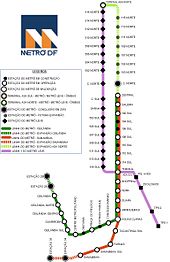Metro Brasília
The Metrô Brasília is the subway system of the Brazilian capital Brasília , which currently consists of two routes. Together they connect Brasília's bus station in the center with the suburbs of Brasilia in the form of a Y- shaped rail . The metro is operated by the Metrô-DF ( Companhia do Metropolitano do Distrito Federal ). Due to the large distances between the individual districts and a city bus system that only worked to a limited extent, a rapid transit system was necessary in the planned Brazilian capital. As a side effect, the area around the Águas Claras station is the fastest growing district of Brasília due to the well-developed subway.
history
After much discussion about an adequate rapid transit system for the capital of Brazil, construction work began on the new rapid transit system in 1992. The opening was originally supposed to take place in 1999, but had to be postponed to 2001 due to financial problems, among other things. By March 31, 2001, the trunk network with the two branches to Terminal Samambaia and Praça do Relógio with a total of 11 stations and 31 kilometers had been completed. The operating company began regular commercial operations on September 24 of the same year. However, the commissioning only included the opening of individual stations in order to start operations as quickly as possible. To date, numerous stations between the Galeria and 114 Sul stations have not yet been completed. The Samambaia Sul and Arniqueira stations opened on February 6, 2002, and the Concessionárias station on May 18, 2004 .
In April 2008, the route was extended via the previous terminus Praça do Relógio to the new terminus Estação 27 (Terminal Ceilândia). Six new stops were created in this area, four of which were initially put into operation: Guariroba, Ceilândia Centro, Ceilândia Norte and Terminal Ceilândia. Station 108 was also put into operation in the same month.
planning
The metro currently only runs through the south wing of Brasília to the center, but in the future it will also be extended through the north wing of the city and end at the future Asa Norte terminal. Furthermore, a tram line (Metrô Leve or VLT) is to be built for the first time , which is to run parallel to the previous underground line in the west of the north and south wings and to lead to the airport in Brasília. It should be possible to change from the tram to the Metrô at the Asa Sul and Asa Norte stops. The tram route was originally supposed to be completed by the soccer world championships in 2014.
business
Routing
The route of the Metrô leads first from the bus station over the southern axis of the Plano Piloto to the south. Initially, both lines have a common route until they fork in the suburb of Águas Claras and one route each leads to Samambaia (Linha laranja, German Orange Line ) and to Taguatinga (Linha verde, German Green Line ). The Metrô is currently served by three lines: Green and Orange Line, as well as the combination of both between Central and Águas Claras . From Central to Asa Sul , the subway runs in the tunnel, the rest of the route west on the surface.
Lines
The Metrô Brasilia network is 31 kilometers long and currently has 14 stations. The trains run from Monday to Friday between 6 a.m. and 11.30 p.m., on weekends and public holidays between 7 a.m. and 7 p.m. On the green line there is a 10-minute cycle all day, on the orange line there is a 20-minute cycle. Companhia do Metropolitano do Distrito Federal currently owns twenty trains with four cars each, and each train can carry up to 1,350 passengers. All stations are equipped with escalators and elevators .
| line | route | opening | Stations |
|---|---|---|---|
| green | Central ↔ Ceilândia | March 31, 2001 | 12 |
| orange | Central ↔ Samambaia | March 31, 2001 | 12 |
Tickets
There is a flat rate of two Brazilian Reals regardless of the distance traveled. There are also rechargeable tickets that can also be used to travel by bus . Access to the stops is only possible with a valid ticket, passengers must pass platform gates with turnstiles at the entrance.
maintenance
The maintenance of the route, stations, signaling technology, power supply and the trains was transferred from the operator Metro DF to the Metroman consortium (with the companies Serveng-Civilsan SA Empresas Associadas de Engenharia and Siemens LTDA ) in October 2007 .
Web links
- Official website of the transport company (Portuguese)
- Route map of the metro
- Photos of the Metrô Brasília, also official photos of the transport company (English)
- Information at urbanrail.net (English)
- Maintenance organization of the metro
Individual evidence
- ↑ Partners selected for Brasilia light rail project on Railwaygazette.com

